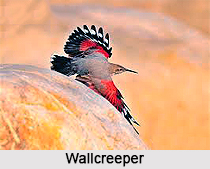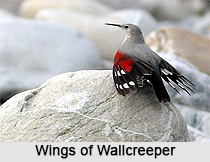 Wallcreeper is an Indian bird that bears a scientific name "Tichodroma muraria" is a small passerine bird found throughout the high mountains of Eurasia.
Wallcreeper is an Indian bird that bears a scientific name "Tichodroma muraria" is a small passerine bird found throughout the high mountains of Eurasia.
Category of Wallcreeper
Wallcreeper is the only member of the genus Tichodroma.
Taxonomic Order of Wallcreeper
There is some disagreement among ornithologists as to where the wall creeper belongs in the taxonomic order. Initially, Linnaeus put it in the family Certhiidae, with the Tree Creepers.
Family of Wallcreeper
Wallcreeper is placed in a monotypic family Tichodromadidae by, amongst others, Clements 2007, while other authorities such as Dickinson 2003 put it in the monotypic Tichodromadinae, a subfamily of the nuthatch family Sittidae. In either case, it is very closely related to the nuthatches.
Structure of Wallcreeper
Wallcreeper is a 15.5-17 centimetres long bird, with a mass of 17-19 grams. Its plumage is primarily blue-grey, with darker flight and tail feathers. It"s most striking plumage feature, though, are its extraordinary crimson wings. Largely hidden when the wings are folded, this bright colouring covers most of the covert feathers, and the basal half of the primaries and secondaries.
Distribution of Wallcreeper
Wallcreeper breeds at elevations ranging between 1,000-3,000 metres. It is largely resident across its range, but is known to move to lower elevations in winter, when it is occasionally found on buildings and in quarries. Birds have wintered as far of field as England and the Netherlands, where one spent two consecutive winters between 1989 and 1991 at the Vrije Universiteit in Amsterdam. The species is resident across much of the Himalayan Mountain Range, ranging across India, Nepal, Bhutan and parts of Tibet.
Behaviour of Wallcreeper
Wallcreepers are territorial in nature. It pairs vigorously defending their breeding territory during the summer. During the winter the wall creeper is solitary, with males and females defending individual feeding territories. The size of these feeding territories is hard to estimate but may comprise a single large quarry or rock massif; or, alternatively, a series of smaller quarries and rock faces. Wall Creepers may travel some distances from roosting sites to feeding territories. They have also been demonstrated showing site fidelity to winter feeding territories in consecutive years.
Feeding of Wallcreeper
Wallcreeper is an insectivore, feeding on terrestrial invertebrates. It primarily fed insects and spiders gleaned from rock faces. It sometimes also chases flying insects in short sallies from a rock wall perch. The feeding birds move across a cliff face in short flights and quick hops, often with their wings partially spread.
Nests of Wallcreeper
Wallcreeper builds a cup nest of grass and moss, sheltered deep in a rock crevice, hole or cave. The nest is lined with softer materials, often including feathers or wool, and typically has two entrances.
Eggs of Wallcreeper
The female Wallcreeper usually lays 4-5 eggs, though clutches as small as three have been found. The white eggs measure 21 mm long, and are marked with a small number of black or reddish-brown speckles. Once her entire clutch has been laid, the female incubates the eggs for 19-20 days, until they hatch. During incubation, the female Wallcreeper is regularly fed by her mate.











